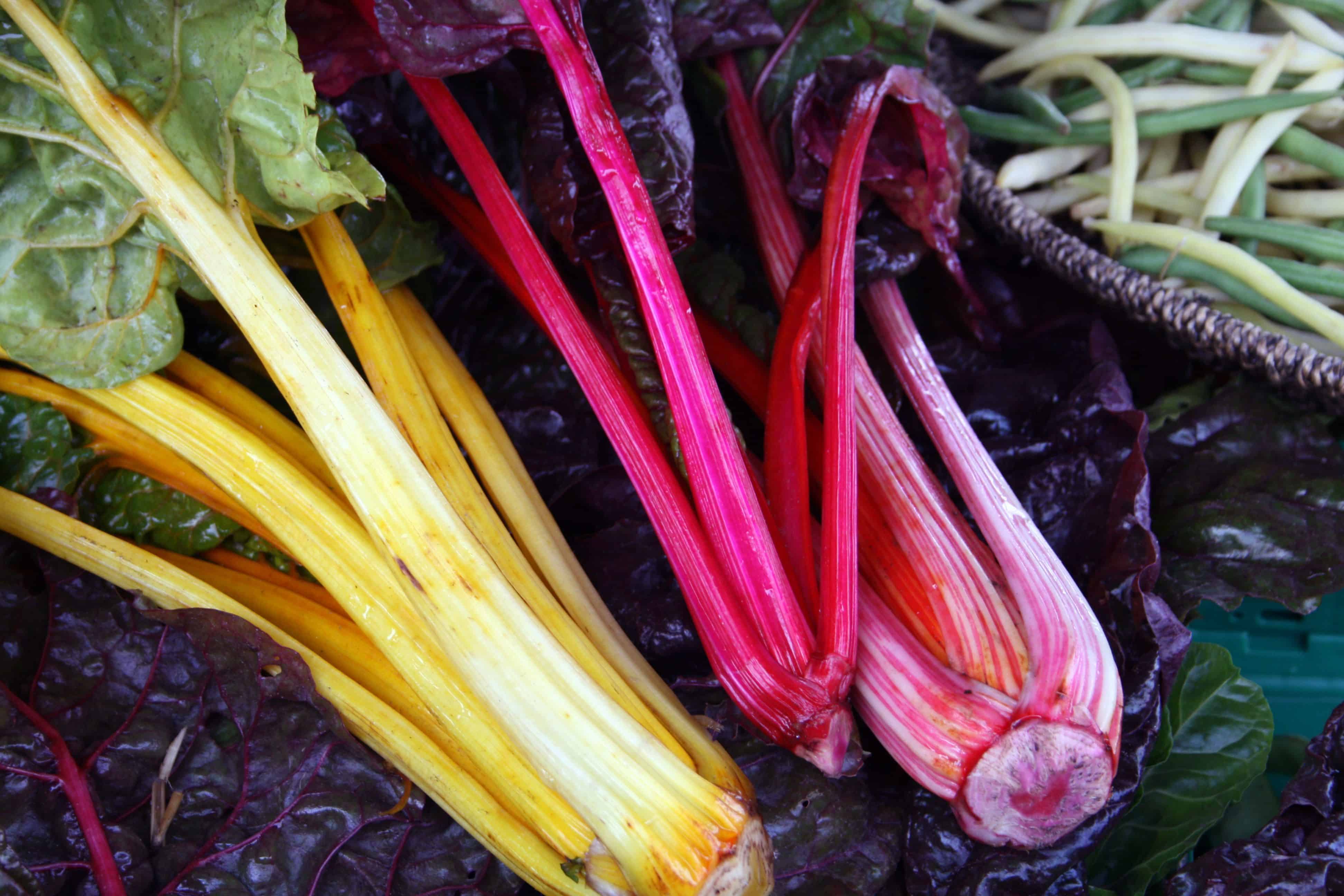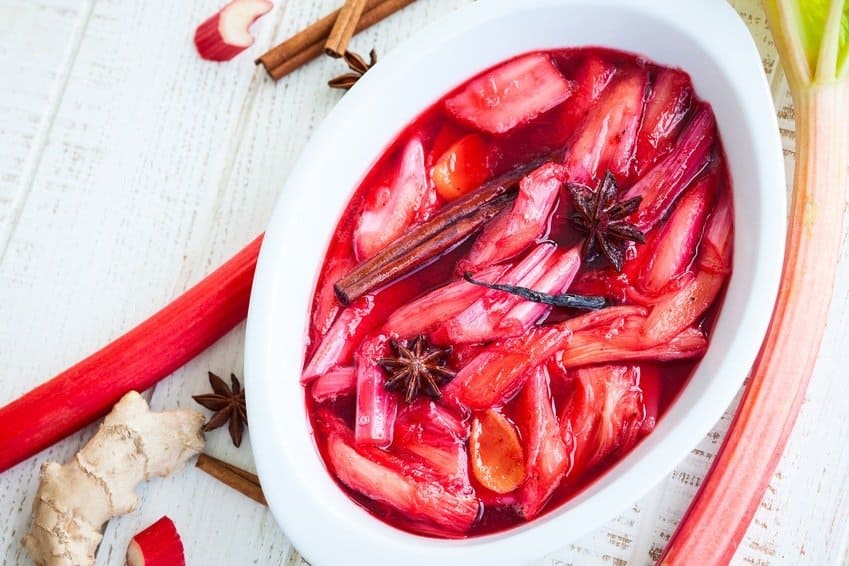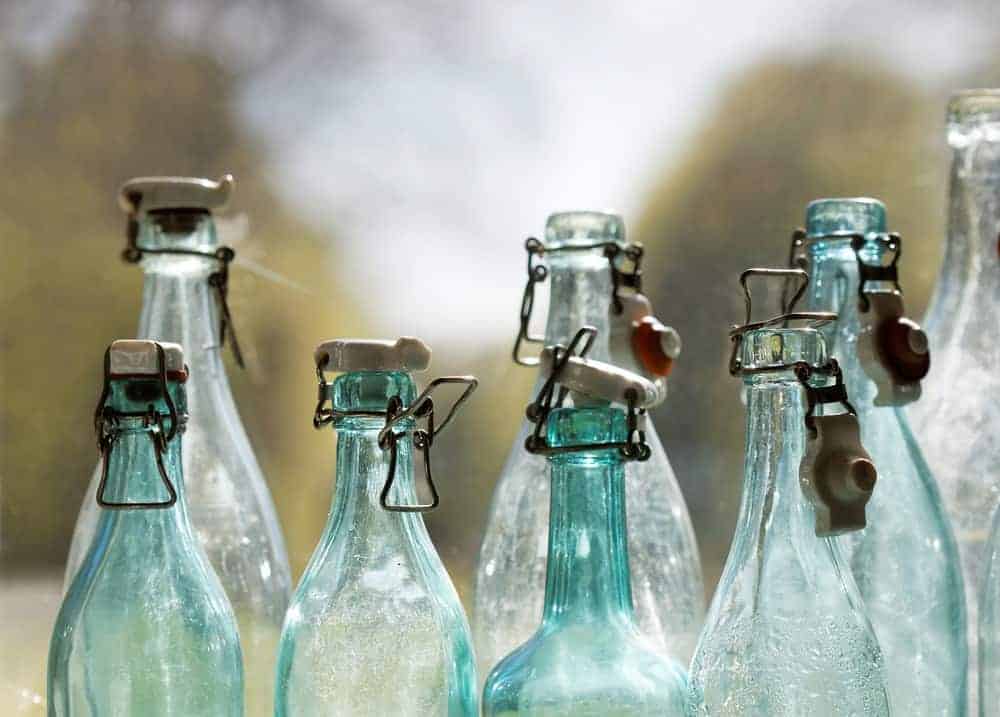Rhubarb Wine Recipe: Light, Pink and Sweet
If you like rose wine, then you need to stop what you’re doing, head to your local market, buy as much rhubarb as you can carry, and start making your own rhubarb wine by following this recipe.
Light, pink and sweet with a subtle sharpness, rhubarb wine is the perfect accompaniment to an al fresco lunch on a warm summer’s day.
It is also surprisingly versatile – adding a curl of ginger will release the spicy base notes of the rhubarb, while a dash of vanilla transforms rhubarb wine into a candy-like confection.
But perhaps the best thing about rhubarb wine is just how easy it is to make.
This is one of the most accessible and forgiving fruit wines on the planet. Rhubarb is so easy to grow that there’s probably a few stems already lurking in your garden without your knowledge, but if you don’t have access to the fresh stuff you can just pick some up from the market.
It is a cheap, vibrant and cross-seasonal fruit that looks amazing poking out of a brown bag or basket. Once you have your rhubarb, all you need is some sugar, lemon, yeast and water and you’re good to go!
And unlike some other fruit wine recipes (I’m thinking of you, elderberry wine), rhubarb wine actually tastes better when it’s young, so you won’t go crazy waiting a year to taste your first batch.
My recipe for rhubarb wine is the process of a lot of tweaking and in my opinion it is the best rhubarb wine I’ve ever tasted.
However, we all have different tastebuds and you might find the addition of root ginger is a bit heavy for your taste, or that you prefer a sweeter, lighter or pinker wine.
We’ll cover all of this below, but in my opinion the best thing you can do is make one batch, enjoy it, then make a second batch straight away with a couple of tiny tweaks. Repeat until you hit the jackpot.
Equipment
Rhubarb wine is a great introduction to the world of homemade wines.
By investing in proper equipment, you will be able to use it again and again as you start experimenting with different types of wine, so go for quality where possible, and always, always make sure you sterilize EVERYTHING before using it.
- A sterilized brew bin, or a food grade basin with a capacity of at least one gallon.
- 2 glass demijohns (at least one gallon in size), plus a fitted airlock and bung
- A large straining bag or muslin cloth
- A vinyl siphon tube (at least 3ft in length)
- 6 glass wine bottles, plus fitted corks and a corker.
- A large funnel
A Note on Corkers
There are a lot of cheap and nasty corkers on the market, so choose your corker wisely. The good news is that once you own one, you’ll never waste a half-drunk bottle of wine again – corkers trump vacuum-sealed wine stoppers every time.
Ingredients
- 3lbs (1.3kg) fresh rhubarb stalks. That’s the pink stalks only, NOT the green, leafy head of the rhubarb. My local rhubarbs are pretty big so 3lbs is the equivalent of around 9-10 stalks. To be safe, grab 12-15 stalks and use any extras to make a delicious fruit crumble.
- 2.5lbs (1.13kg) granulated sugar
- 1” of fresh root ginger or 1tsp of root ginger powder
- Juice and zest of one lemon, or 0.5oz (15g) citric acid
If using a lemon, make sure it is unwaxed. When removing the zest, be very careful not to remove any of the white pith below, as this has an extremely bitter taste that will change the wine completely. I like to be extra careful by using a lemon zester
- White wine yeast. Follow the instructions on the pack for details on how much to use. If you can’t find white wine yeast, red wine yeast or champagne yeast will also do the job – see, I told you rhubarb wine was versatile!
- Yeast nutrient. Follow the instructions on the packet to find out how much to use.
- Campden tablets to sterilize. They kill off any unwanted bacteria that might stop the yeast from working effectively.
- Wine stopper/stabilizer such as potassium sorbate
Our Rhubarb Wine Recipe
STEP ONE – Identifying your rhubarb
At any given moment, there is a forgotten crop of rhubarb growing somewhere in the world.
Rhubarb is one of the most hardy, resilient fruits in the world, and it grows pretty much all year round.
In the Northern Hemisphere, harvesting season starts in April and can go right on through to the end of the summer.
In the Southern Hemisphere, rhubarb is ready to pick in early October. Rhubarb loves sunlight, so if you want to grow your own, just find a sunny spot in your garden (if you don’t have a garden they will grow quite happily in pots).

However, it’s best not to go foraging for ‘wild’ rhubarb for the simple reason that you might accidentally collect one of the world’s most hated weeds.
Rhubarb bears a lot of similarities to the dreaded Japanese Knotweed. They grow in the same places, at the same time; they both have white, fluffy flowers, billowy green leaves, and greenish-red stalks.
Japanese knotweed is a particularly aggressive plant. It spreads quickly and once you have it, it is extremely hard to get rid of it. Its root system is strong and complex, and has been known to break through concrete foundations, rip open roads, and ruin pipe mains.
Meanwhile, the thick upper canopy successfully blocks out all sunlight, killing off any vegetation that lies below.
It is listed as an ‘invasive weed’ in 12 US states, and it’s actually illegal in Australia. Trust me – you do NOT want to bring this stuff onto your property.
The easiest way to tell if you are looking at rhubarb or Japanese Knotweed is to check the stems. Rhubarb stems resemble celery in shape, with straight, fibrous ridges running vertically down the stems.
Japanese Knotweed looks more like a bamboo stick – the stem is cylindrical and smooth with little nodes running in rings all the way down.
Of course, you could just go to your local market and look for a sign which says ‘Rhubarb For Sale’.
STEP TWO – Preparing your rhubarb
To prepare your rhubarb, simply cut off the leafy top (I usually cut from around one inch below the leaf, as this top part can be quite bitter), and trim the ends.
Give them a good wash, and then chop the stems into half inch pieces. And that’s it!
STEP THREE – Perfecting your recipe
This is where we might agree to disagree. First I’ll take you through the basic rhubarb wine recipe, then I’ll share my own version with you.
However, you can tweak and change things to your heart’s content until you have a recipe that’s unique to you.
BASIC RECIPE
- Put the chopped rhubarb, sugar and citric acid into your sterilized brew bin or food grade basin, and mix together.
- Cover and leave the fruit to macerate for at least three days, until it starts to go mushy.
- Use a clean rolling pin to mash up the fruit as much as possible.
- Boil 7 pints (4 liters) of water, allow it to cool, then pour it over the rhubarb. Mix well.
- Strain the rhubarb liquid in a straining bag or through a muslin cloth, squeezing tightly to release as much juice as possible.
- At this point, you can add a little extra water (either boiled and cooled, or filtered) or grape juice concentrate to get the mixture back up to a gallon again.
- Add a crushed Campden tablet and stir. Allow to rest for 24 hours before starting the next step.
- Then add the yeast nutrient and wine yeast, as per the instructions.
- Cover the mixture again and leave for 5-7 days.
ALTERNATIVE RECIPES
When I make rhubarb wine, I follow the exact same process, but instead of citric acid, I juice and zest one whole lemon (unwaxed), and mix it in with the rhubarb and sugar.
At this point, I also add a finely grated one-inch piece of root ginger – this creates a lovely depth of flavor, and a hint of spiciness in the finished product, but I understand that this isn’t for everyone.
If you love a spicy, rich flavor, you could experiment with spices such as cinnamon or star anise, perhaps with a few slices of orange zest or dried orange peel as well.

For a sweeter drink, cut a vanilla pod down the middle until the seeds are revealed, then add it to the fruit mix.
Alternatively, chop up a few handfuls of sultanas or raisins and add them to the mix early on – the natural sugars of the dried fruits will help break down the fibrous rhubarb stems and result in a sweeter wine.
And if all you’re really concerned about is getting the pinkest color possible, add 4oz of strawberries or sweet cherries.
If you don’t want your wine to be too sweet, remove 4oz of rhubarb for every 4oz of strawberries or cherries used.
STEP FOUR – Moving the mixture
After a week, your rhubarb liquid should be well on its way to becoming wine. Check on your brew every day – there will initially be a rush of bubbles to the surface, as the yeast reacts with the sugars and starts to turn them into alcohol.
After a few days, the bubbling should have calmed down a bit. If you still have a thin layer of foam along the top after a week, just skim it off and discard it.
Now you are ready to move your mixture from the sterilized basin into a demijohn.
Using a funnel and/or a soup ladle, transfer all the rhubarb liquid into your demijohn, leaving behind any tiny bits of sediment at the bottom of the basin.
You will probably find that the mixture doesn’t quite reach the top of a one-gallon demijohn, so just add a few splashes of cool filtered water and a teaspoon or two of sugar until your demijohn is full.
Now pop in your bung and the airlock, making sure that they’re completely air tight. And wait! For another month…
STEP FIVE – When the bubbles stop
You should store your demijohn in a cool, dark place where you can keep an eye on it every once in a while.
To begin with, the airlock will be bubbling away, and there will be a constant stream of fizz coming up from the bottom of the bottle.
After a few weeks, the bubbling will pretty much stop and the fizzing will become slower and slower.
Once you count at least a few minutes between fizzes, it’s time to move on to the next stage: racking.
STEP SIX – How to rack your wine
Racking wine is easier than it sounds. It’s basically just the process of getting your wine from one demijohn to another, so you can leave behind the yeast and fruit sediment that has collected during the fermentation process.
And how do you move the wine without making an enormous mess? With your siphon tube of course!
Place the empty (and recently sterilized!) demijohn on the floor, and the wine-filled demijohn on a flat surface (a table or chair) a few feet above the floor.
While you’re moving the demijohn full of wine, be careful that you don’t disturb the sediment at the bottom, as that will make this next part very difficult.
If the sediment does start to rise, just leave the demijohn to sit on the table for a few hours then come back to it.
Remove the bung and dip the siphon into the wine, until its sitting around half an inch from the bottom. It’s very important that the end of the siphon tube doesn’t touch the sediment at any point.
Now take the other end of the tube, and suck! Keep sucking until you taste something resembling wine, then quickly put the tube into the clean demijohn and watch it fill up with lovely pink liquid.
As the ‘floor’ demijohn starts to fill up, you can move the siphon a little further down into the original container, until it is *just* above the sediment layer.
Then stop the racking process by removing the siphon as quickly as possible. I probably should have mentioned, you may want to put a towel down for all this – there will be spillages.
Top up your second demijohn with some filtered water, and add the campden tablets and wine stabilizer (following the instructions on the pack) to stop any further fermentation.
Sterilize your bung and airlock and pop them onto the wine-filled demijohn, then leave it again in a cool, dark place for at least another month.
Recommended: Don’t miss our ultimate honey mead recipe!
STEP SEVEN – When is it ready?
You can technically start bottling your wine any time after the racking process, but the longer you leave it, the clearer and more ‘wine-like’ your rhubarb wine will be.
And then of course, there’s the small matter of the taste. The longer you leave it, the drier it will become, so it’s best to keep tasting it every week or so until you think you’ve nailed the flavor.
This may be a week after raking, or it may be a year – it’s entirely up to you. Personally, I think rhubarb wine tastes better when it’s young and slightly sweet, so I would start bottling it after four weeks, and drink it pretty much immediately.
However, due to the addition of lemon zest and ginger, my version of rhubarb wine is probably less sweet overall than most others, so if you aren’t following my recipe, you might want to wait for six weeks or longer.
STEP EIGHT – Bottling up!

This is my favorite part of the wine-making process, as it means that the wine is nearly ready to drink!
Make sure your bottles and your second demijohn are all well sterilized, and then you can get to work.
First, rack your wine one more time so you have the clearest liquid possible – no one wants to be scraping yeast sediment off the roof of their mouth after every gulp of wine.
You know what you’re doing now, so this should be easy!
When you’ve finished racking, move your wine-filled demijohn onto the table and line up your bottles on the ground below. Then use your siphon to fill each and every bottle with rhubarb goodness, until it’s all gone.
Use your corks and corker to seal the bottles, and voila! You’re done!
Don’t forget to label your wine with the ingredients, bottling date, and any other useful information. The rhubarb wine will keep for years to come, although it probably won’t last more than a few months…!
Personally, I like to treat rhubarb wine as a good rose, and serve it chilled in the sunshine with a fresh bowl of pasta in a creamy sauce.
Rhubarb wine also works incredibly well in cocktails – make your own martini by mixing wine with a splash of brandy and some white vermouth, and serving it in a martini glass with a twist of ginger and a slice of orange.
Or lighten things up with a rhubarb wine spritzer – equal parts wine and soda water, served over ice with a strawberry garnish.
Get in touch and tell us how you’re drinking your rhubarb wine, and what flavor combinations you went for in your recipes.
Conclusion

In the right hands, homemade rhubarb wine can rival French and Spanish roses – in fact, why not conduct a blind taste test with your wine-loving friends and see if they can tell the difference?
Unlike many other homemade concoctions, rhubarb wine is uncomplicated and light, with a sweet and spicy aroma and slightly floral high notes.
This is a wine that you’ll want to keep close at hand, in your refrigerator, 365 days a year. Or at least on the sunny days.
So now that you know how easy it is to make your own fruit wine, why not try making another batch of something different?
Check out our other fruit wine recipes, and share your experiences in the comments below. We are always keen to hear how you got on with your wine-making projects so don’t be shy!
Finally, if you liked this article, please feel free to share it with everyone who appreciates a nice glass of wine.

Lovely recipe. I’m puzzled by the picture of swiss chard, though.
Hi the wineturtle recipe for rhubarb wine features a photo of swill chard–not rhubarb. Rhubarb grows with single stalks